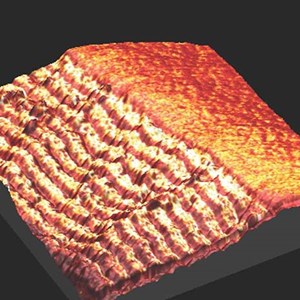Nov 4 2013
A new class of materials developed at the University of Arkansas may influence the next generation of nano-devices, in which integrated circuits are composed of many layers of dissimilar materials, such as ferromagnetic and superconducting oxides.
 Cross-sectional image of the multilayer structure on nanoscale
Cross-sectional image of the multilayer structure on nanoscale
The researchers used innovative cross-sectional scanning tunneling microscopy and spectroscopy at the U.S. Department of Energy’s Argonne Center for Nanoscale Materials to develop the first direct view of the physical and chemical behavior of electrons and atoms at boundary regions within the dissimilar materials.
“The fundamental issue here is that conventional modern day electronics based on silicon is very problematic to operate on a nanometer scale,” said Jak Chakhalian, professor of physics in the J. William Fulbright College of Arts and Sciences at the University of Arkansas. “Integrated circuits have many, many layers of functional material. As layers get thinner, the materials start behaving strangely and often unreliably. Now the question of the size of the interface, where two materials ‘talk’ to each other or influence each other, becomes critical.”
An article detailing the finding, “Visualizing short-range charter transfer at the interfaces between ferromagnetic and superconducting oxides” was published Aug. 13 in the online journal Nature Communications.
Te Yu Chien, a former postdoctoral research associate at the university, developed a technique at the Advanced Photon Source at Argonne to help Chakhalian’s research group with an easy way of looking directly at the interfaces between two dissimilar oxides.
“That was the breakthrough,” Chakhalian said. “He found the ‘knife’ that would cut through the multilayered ‘sandwich.’ Previously, it was extremely difficult, if not impossible, to look inside the layered complex oxide nanomaterial that we had developed here in our lab because they fractured when they were cut.
Chien’s technique provided the researchers with crucial information: Not only do the atomic layers talk to each other, but they also deeply influence each other on a one- to two-nanometer scale.
“We learned that in our materials, the layers strongly influence each other,” Chakhalian said. “For the first time, we showed how electrons and ions interact on the atomic scale in those complex multilayered structures, and it was not what a lot of people expected. This is fantastic. So now we can have beautiful control of these materials on the atomic scale obtained right at the interface, which defines the properties of those materials.”
Chakhalian holds the Charles E. and Clydene Scharlau Endowed Professorship and directs the Laboratory for Artificial Quantum Materials at the University of Arkansas.
The results were obtained by a collaborative effort with John W. Freeland of the Advanced Photon Source and Nathan P. Guisinger of the Center for Nanoscale Materials, both at Argonne National Lab outside Chicago; and Lena F. Kourkoutis and David A. Muller at the Kavli Institute at Cornell for Nanoscale Science in Ithaca, N.Y.